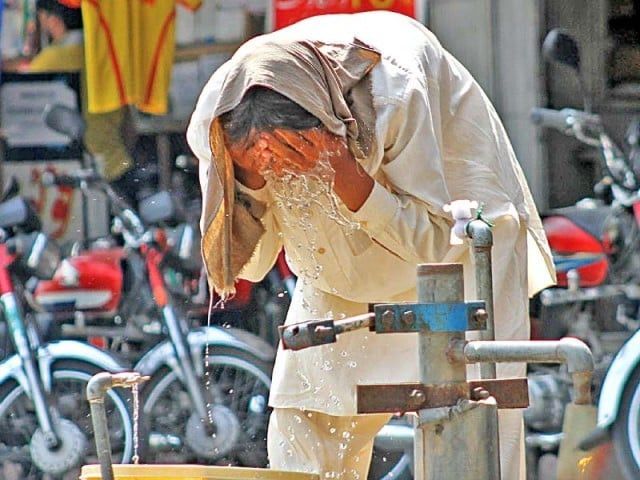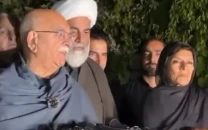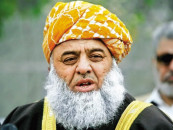Inexperience, poorly constructed houses led to most heatwave deaths last year
Experts believe early warnings of temperature and humidity may have saved lives

A man smears his face with water from a public tap in Islamabad. PHOTO: INP
Even though other cities of Sindh experience temperatures much higher than Karachi, such as Larkana, Jacobabad and Mithi, the mortality rates were lower as locals in other cities were well adapted to cope with the rising heat. Figures provided by the Provincial Disaster Management Authority Sindh revealed that 60% of the deaths took place at homes, while 40% of them occurred due to direct sun exposure.
Lack of awareness was the major issue last year, leading to the high number of deaths in Karachi, according to Strengthening Participatory Organisation’s chief executive Naseer Memon. “People had never experienced heatwaves of such magnitude [in Karachi] before and they were unaware of how to cope with it,” said Memon. The solution for Karachi is awareness, adaptation and protection of natural environment, he suggested.
On the other hand, Karachi chief meteorologist Abdul Rasheed, who is also the spokesperson for Pakistan Meteorological Department (PMD) Sindh, mentioned the reason for Karachi being the most affected was its building structure, coupled with suffocation that makes its population vulnerable to heatwaves. “Temperatures are much higher in Dadu, Nawabshah and Sukkur but the way houses are constructed in such cities reduces the impact,” he explained. “A few days back, Dadu crossed 45°C but no casualties were reported as people have learned to adapt to higher temperatures.”
Changing conditions
Heatwaves occur when the daily maximum temperature exceeds the average maximum temperature by 5°C for more than five consecutive days. The change in weather conditions, according to World Meteorological Organisation’s special adviser Dr Qamaruz Zaman Chaudhry, is due to the presence of air depression over the Arabian Sea that cuts off the incoming sea breeze to Karachi.
“This high air pressure, prevailing over Balochistan and parts of Sindh, is further exacerbated by clear skies that make the air warmer and more stagnant,” said Chaudhry. He also gave Urban Heat Island (UHI) effect, a phenomenon whereby slightly warmer air develops over urbanised areas, as a reason behind Karachi’s inability to tolerate the heat. “This synoptic situation increased temperatures in Karachi, leading to prolonged heatwaves last year,” said Chaudhry. The former director-general of Pakistan Meteorological Department (PMD) also termed human-induced factors, especially water and power shortages, as major contributors to recorded death tolls.
Apart from the UHI effect, fewer trees and the imbalance in concrete structures and green areas also fuels climate change, said PMD director-general Dr Ghulam Rasool, adding that the the met office’s role should be to issue warnings three days prior to the heatwave. “Warnings should be shared with local stakeholders and then everyone should be alerted daily about the intensity, temperature, wind direction and speed, and air humidity of the heatwave every hour,” he suggested.

According to Dr Daniele Bocchiola, an associate professor at Civil and Environmental Engineering Department of Politecnico di Milano in Italy, Pakistan is undergoing different risks arising from climate change, including heatwaves and other extreme climate changes. These may cause increase in mortality, especially for children and elders. As a result, there’s a need to prepare and implement early warning and emergency management plans for heatwaves.
“The modelling effort of the Intergovernmental Panel on Climate Change may be of use to assess the potential effect of ongoing climate change upon the frequency and magnitude of the heatwave,” said Dr Bocchiola. “Since awareness regarding heatwaves is low in Pakistan, efforts should be made to increase it and provide guidelines for managing climate-related risks.”
Summer of extremes
April 2016 was the warmest April ever recorded; it was 1.11°C warmer than the average temperatures of the month experienced between 1951 and 1980. According to data released by NASA, it was also the seventh consecutive month to break previous global temperature records. This makes climate experts believe 2016 will be the hottest year on record.
Managing heatwaves
Taking notes from last year’s rising deaths and a lack of effective protocols, the government has made an effort to prevent fatalities this year. Leadership for Environment and Development (Lead) Pakistan and Climate and Development Knowledge Network (CDKN) are assisting the Government of Sindh and relevant authorities to facilitate Karachi in heatwave management planning. According to Lead CEO Ali Tauqeer Sheikh, who is also the Asia director at CDKN, effective coordination between various departments and civil society can be ensured through a heatwave management plan. “There’s a need to have content appropriate mitigation strategies, as they are different for every city. As strategies at the grassroots level are interpreted differently, they should be localised,” suggested Sheikh. “This will save lives, as these are preventable deaths,” he adds.
The writer is an international award-winning environmental writer with an interest in climate change, deforestation, food security and sustainable development. He tweets @SyedMAbubakar
Published in The Express Tribune, May 24th, 2016.



















COMMENTS
Comments are moderated and generally will be posted if they are on-topic and not abusive.
For more information, please see our Comments FAQ